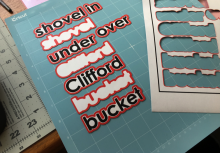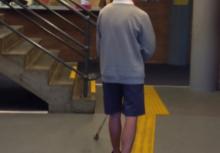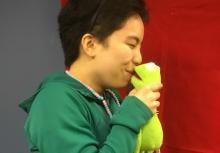Assistive technology (AT) for math consists of items and devices that range from low- to high-tech. Low-tech items may include manipulatives, such as money, shapes and solids, or measuring devices. High-tech devices can include, but are not limited to,...
All

Posted by Liz Eagan
A student of mine is what I call "tactually hesitant". She's not defensive, just hesitant with new textures and experiences. She is in a life skills class and is learning braille, and recently she surprised me! It took me nearly a school...

Posted by Paths to Literacy
Submitted by Gerald Abner, Clinical Instructor with the Teacher Preparation Program for Visual Impairments and Jasamyn Nichols DeGrant a graduate of the program and Teacher of the Visually Impaired in Clark County Schools
Students who are blind or...

Posted by Liz Eagan
One of my students has been working with me for two and a half years on becoming more independent in cooking, learning new recipes, and learning to use new appliances and cooking implements. This year she is a senior, so at her annual IEP meeting we made a...

Posted by tracy.wilks
Environmental modifications in the classroom can help students with cortical visual impairment (CVI) to function more independently. Many of these modifications could benefit other students as well, by reducing visual clutter and complexity. While...

Posted by Diane Sheline
Having the new Roman Word Bubbling tool to create “Bubble” Words has been extremely helpful for those of us who use “Bubbling” as a strategy for increasing literacy skills in our students with CVI. Developed by Dr....

Posted by Charlotte Cushman
In their webinar Trust the Process: A Case Study in Literacy and CVI, TVIs (Teachers of the Visually Impaired) Amanda Whelan and Joy Wilson share tips and guidelines to adapt literacy materials for a Kindergarten student (Krish) with cortical visual...

Posted by formicap
My sister and I developed this book series. She is deafblind with a renewed interest in learning braille. We are in our fifties and she uses tactile American Sign Language (ASL).
This is our second book in ASL form to help smooth the...

Posted by Debra Goodsir
It’s amazing how much the example of a competent older student with a vision impairment can impact on all of the outcomes for younger students with vision impairments. And it’s equally amazing how allaying one basic fear in a learning setting can...

Posted by Cecilia Robinson
As a new school year starts up, many teams are looking for the best ways to evaluate students with visual impairments for the most appropriate assistive technology. Here are some tips and resources to help you get started.
Identify a clear...

Posted by Charlotte Cushman
The start of a new school year brings a wide range of emotions: excitement about new beginnings, happiness in reconnecting with students and colleagues, and wistfulness at saying goodbye to the summer break. For new Teachers of the Visually...

Posted by Linda Choy
Linda Choy is the mother of a young woman with MDVI in the Philippines.
It has been 7 years since I wrote about Kara, who for a long time struggled with reading and writing braille, until she found that braille could help her reach out to her friend...

Posted by Jasmyn Polite
Over the years, I have worked hard to become an independent, successful young woman with dreams of helping children who are blind or visually impaired grow into successful adults. Florida School for the Deaf and Blind (FSDB), my family, Iowa Department for...

Posted by Pinar Safak
Busem is a young girl in Turkey, who was born at just 26 weeks. She was 700 grams and she spent her first 3 months in an intensive care unit. Due to Retinopathy of Prematurity (ROP), she lost vision in both eyes and surgery was not able to restore her...

Posted by Linda Choy
My daughter Kara was born on 10/14/1998, at 6.5 months gestation. She weighed 1.2 kgs, and had an extremely difficult survival course. As a result, she is blind due to retinopathy of prematurity, she also has mild cerebral palsy and has global...

Posted by Charlotte Cushman
Many teachers around the world struggle to meet the divergent needs of students who are different ages with very different needs and abilities. Not every school has the luxury of grouping students by age and ability, and this can be a challenge for both...

Posted by Carlie Rhoads
Constant time delay, or CTD, is a technique that has been shown to be an effective intervention strategy to teach braille contractions to dual media learners making the transition from print to braille. A research study was conducted at Vanderbilt...

Posted by Linda Hagood
Katrina loves Frogs and Braille. During the past school year, she has become an authority on her favorite frog, Kermit, especially in his Sesame Street role as "News Flash Reporter." She has created a series of fantasy stories in which she and...

Posted by Liamsmom
This year for my son's birthday, we sent out invitations for his party at the park. I asked that, if people wanted, for them to email me a birthday message for Liam to make into a birthday book at the party. Once they emailed me the messages I...

Posted by Charlotte Cushman
Renee Toy, who is the librarian at Texas School for the Blind and Visually Impaired (TSBVI) recently sat down with Outreach Director Emily Coleman to discuss summer reading. Their conversation is part of the podcast series A Sense of Texas. Listen...

